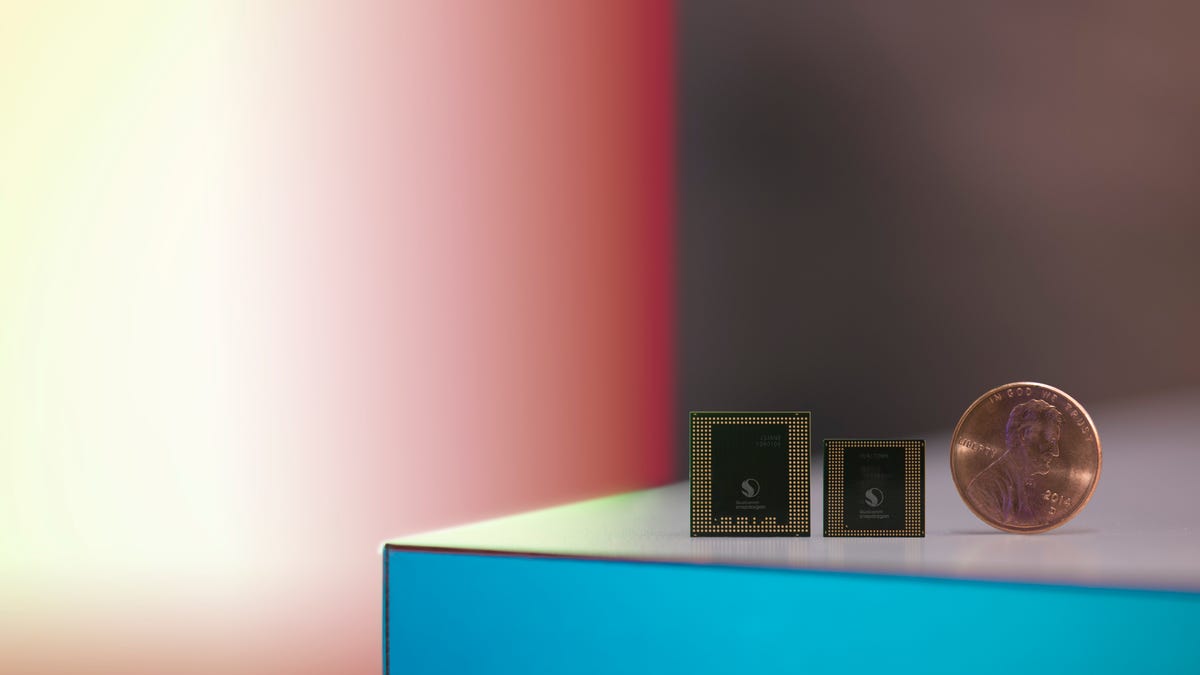Qualcomm's new chip may finally get you to try VR
The Snapdragon 835 includes tweaks, like Wi-Fi built onto the chip, that allow for thinner, lighter and more powerful devices.

Qualcomm's new chip, the Snapdragon 835 (center) is 35 percent smaller than its predecessor, the Snapdragon 820 (left).
Virtual reality has gotten a lot of buzz, but not a lot of users.
That could change this year with the newest mobile chip from Qualcomm, detailed Tuesday at the CES trade show in Las Vegas. The company's Snapdragon 835 processor with X16 LTE packs features that enable companies to make smaller and lighter devices -- as well as more powerful gadgets like VR and augmented reality headsets. And the first devices will show up early this year.
Qualcomm said the processor will be used in everything from smartphones to PCs. It will power VR headsets that rely on phones (like the Samsung Gear VR or Google Daydream View) and standalone VR and AR devices, like Osterhout Design Group's R-8 AR/VR smartglasses, also unveiled Tuesday.
"Everyone wants their phone to have a greater degree of contextual awareness and [do it] at a lower power," Keith Kressin, Qualcomm senior vice president of product management, said in an interview last month ahead of CES. "Relative to our previous generation [chip], 835 is better in every respect."
Qualcomm makes more wireless chips than any other company on the planet, and its high-end processors dictate what our mobile devices can do. The company's Snapdragon processors are used in designs from Samsung, LG and others, and Apple uses Qualcomm's LTE chips in the iPhone.
Devices using Snapdragon 835 will hit the market in the first half of the year. Phones powered by the chip will likely make their debut at the Mobile World Congress trade show next month. The Samsung Galaxy S7, unveiled at last year's MWC, was among the first phones that hit the market with Qualcomm's Snapdragon 820 processor.
The octa-core Snapdragon 835 features a CPU with four cores running up to 2.45GHz and four lower-power cores running up to 1.9GHz. Qualcomm focused on five areas while developing the new chip: battery life, immersion, camera quality, connectivity and security.
In terms of battery life, the Snapdragon 835 takes up 35 percent less space than its predecessor and consumes 25 percent less power. That means users get about 2.5 more hours of use. And the chip comes with Qualcomm's Quick Charge 4 technology, which the company says will give a phone five hours of battery life with just five minutes of charging.
Immersion is where VR and AR come in. Snapdragon 835's graphics are 25 percent faster, and it supports up to 60 times more colors than its predecessor. It also supports 4K Ultra HD premium (HDR10) video, 3D audio and wide color gamut 10-bit displays, instead of 8-bit, among other features.
Along with a more immersive experience, devices powered by the Snapdraon 835 will have better still and video camera abilities. Qualcomm built in smooth optical zoom capabilities, fast auto-focus technologies and HDR true-to-life colors. Its Spectra 180 camera ISP technology enables up to 32MP single or dual 16MP cameras.
"There are going to be a lot of innovations in the camera in 2017," Kressin said. "Most [handset makers] will go to two cameras on their phones, similar to the higher end iPhone today."
With connectivity, the Snapdragon 835 comes integrated with the X16 Gigabit Class LTE modem and 2X2 802.11ac Wi-Fi for fast speeds at home and on the go. There's also an option for 802.11ad, the next version of Wi-Fi. The Snapdragon 835 is the first chip from Qualcomm that comes with Wi-Fi integrated. That allows the chip to take up less space and consume less power.
For security, the Snapdragon 835 enables fingerprint, iris and facial recognition to unlock and authenticate devices.
Qualcomm in November gave its first information about Snapdragon 835, the first mobile processor to lean on a 10-nanometer manufacturing technique from Samsung, which packs millions more transistors -- the engines for processing power -- into a tinier chip. The process deals with an almost unfathomably small scale; 10 nanometers is 6,000 times shorter than the diameter of a strand of human hair. The previous Snapdragon 820 and 821 processors utilized a 14-nanometer manufacturing technique.

